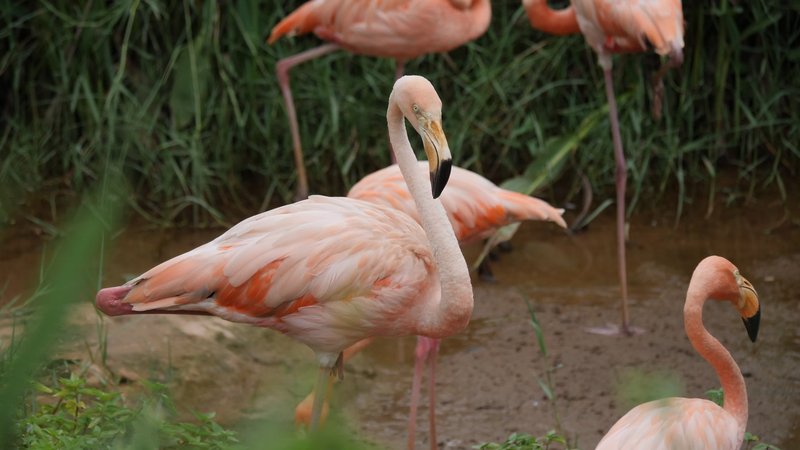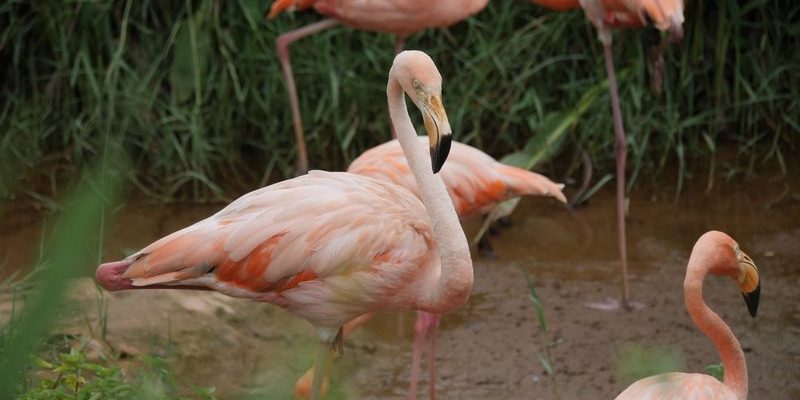
But how do these charismatic birds manage to adapt so well? From their habitat selection to their feeding habits and social interactions, flamingos have developed some pretty remarkable traits to navigate their world. Let’s dive into the various adaptations that make flamingos so special and explore how these adaptations help them thrive in often harsh conditions.
Habitat Preferences: The Right Environment Matters
Flamingos are pretty picky when it comes to their homes. They thrive in shallow lakes, lagoons, and coastal wetlands. These areas are often rich in the algae, brine flies, and other organisms that make up their diet. Think of these habitats as their buffet, serving up everything they need to survive and grow.
Interestingly, flamingos prefer places that might seem inhospitable to other animals: areas with high salinity or alkaline water. You might be wondering why they favor these conditions. Well, it’s because their primary food source, tiny crustaceans and algae, flourish in these environments. The high salt levels can be a problem for most wildlife, but not for our feathered friends!
Their ability to live in such unique habitats showcases their adaptability. It’s like they’ve got a built-in GPS for finding the best spots to feed and nest. This flexibility in habitat choice not only keeps them safe from predators but also provides an abundant food supply, a win-win for these stunning birds.
Unique Feeding Mechanism: Nature’s Design
Feeding is a big part of a flamingo’s life, and they’ve got some incredible adaptations that help them eat. They have long, curved beaks that are perfectly designed to sift through water and mud. Imagine trying to sip a smoothie with a straw that’s bent—this is how flamingos work their magic.
When they feed, they often turn their heads upside down and sweep their beaks through the water. This unique motion allows them to filter out tiny organisms like brine shrimp and algae. Their beaks are equipped with special plates that trap food while letting water flow out. It’s like using a colander, but with a bird-sized twist!
By adapting their feeding style to the available food sources in their environment, flamingos ensure they get the nutrients they need. This capability is a big reason why they can thrive in places where other birds might not find enough to eat.
Coloration and Camouflage: Pink Isn’t Just Pretty
One of the most iconic features of flamingos is their striking pink color. But did you know that this beautiful hue is a result of their diet? The pigments found in the algae and crustaceans they consume contain carotenoids, which are responsible for that vibrant pink.
When flamingos eat these foods, the pigments get deposited in their feathers, skin, and even their bills. A fun fact: the more they eat, the pinker they get! Interestingly, young flamingos are born gray and only gain their color as they grow older and start eating the right foods.
This coloration isn’t just for show; it also plays a role in their social interactions. The bright feathers can help attract mates and signal health. So, while the pink is stunning, it serves an important function in flamingo society. It’s like wearing your best outfit to a party to show off your health and vitality!
Social Behavior: The Power of Community
Flamingos are very social creatures, often found in large colonies that can number in the thousands. This social behavior is crucial for their survival. Being in groups helps protect against predators, as there’s safety in numbers. It’s much harder for a predator to target one flamingo when there are so many around!
These birds also perform fascinating social rituals, such as synchronized dancing and vocalizations that strengthen their bonds. Imagine a flash mob at a concert; it’s similar when flamingos engage in these communal displays. This synchrony not only reinforces connections among individuals but also helps coordinate breeding and nesting.
By living in large groups, flamingos can communicate more effectively and respond to environmental changes. Their social structures help them adapt to shifting conditions, ensuring their survival as a species.
Breeding Strategies: Nesting in Style
When it comes to breeding, flamingos have some pretty interesting strategies. They build their nests in mud, forming a mound that elevates their eggs above the water. This clever design protects the eggs from flooding and environmental dangers. It’s a bit like building a little fortress for their future chicks!
In colonies, flamingos often nest close together, which provides additional protection. This communal nesting can create a miniature city of flamingos, all working together to raise the next generation. Here’s the thing: if one flamingo is vigilant and sees a threat, it can alert the others, giving everyone a better chance of survival.
The breeding season can vary based on location and environmental conditions. In some areas, they might breed only when conditions are just right. This adaptability ensures that flamingos can maximize their reproductive success, only laying eggs when they have the best chance of raising healthy chicks.
Behavioral Adaptations: Staying Ahead of the Game
Flamingos exhibit various behavioral adaptations that help them survive in challenging environments. For example, they’re known to migrate based on food availability and weather conditions. This seasonal movement allows them to find suitable habitats while avoiding harsh conditions.
During harsh weather, such as droughts or extreme heat, flamingos can adjust their feeding and nesting strategies. They might move to new locations or change their diet slightly to adapt to whatever food sources are available. This versatility is key to their survival in the wild.
Additionally, flamingos communicate through a range of vocalizations and body language. This ability enhances their social interactions and helps them find mates, raise young, and stay organized as a group. By being responsive to their environment and to each other, flamingos are able to thrive no matter where they find themselves.
Flamingos are more than just pretty birds; they’re incredible examples of how life adapts to fit its environment. From their unique feeding habits and vibrant coloration to their social behaviors and breeding strategies, they showcase the beauty of adaptation. It’s a reminder of the resilience found in nature and how species like flamingos can thrive in environments that seem tough for other living things.
Next time you see a flamingo, consider all the remarkable ways it has adjusted to survive and thrive. Each aspect of their life is intertwined, forming a beautiful tapestry of life that’s all about making the most of their surroundings. Flamingos truly are a testament to nature’s creativity and tenacity!

